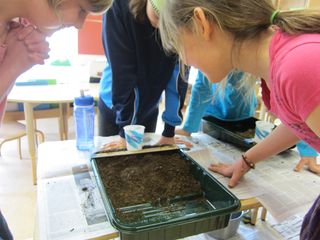Erosion!

What is erosion? With all the study we've been doing of the landscapes of our different Native American tribes, Opal 3 recently zoomed out on the scale of time, and zoomed in on landscapes through the lens of what makes them change over time. What changes landscapes? What is there to notice about the landscapes immediately around us? What are our emerging theories about how erosion works?
Along with our theories and observations, came several questions:
IM: What would happen if erosion got blocked?
RS: Does it matter if the landscape is hit or run over by heavier things versus lighter?
AA: What will happen if erosion keeps happening?
SK: What caused the first erosion?
HG: If people are pulling weeds, are they causing erosion?
SE: Why does erosion happen? Are people bad if they cause erosion?
WK: How does clay erode? Or some other material in the landscape?
BK: Can erosion happen on flat land?
AB: Could erosion shape a landscape so much that mountains could become flatlands, or make the mountains go under sea level?
SD: Can an erosion form by itself, without humans, just earth?
MG: Is erosion good or bad? I was wondering if some of the landmarks we have today could have been made by erosion?
So many questions! We knew, with all the energy and interest around these questions, this would be the perfect exploration and investigation for our yearly science work samples. Children were invited to play with their ideas about erosion, to test them out informally in the classroom:
After testing out a few ideas and theories, we found the children were especially curious about water flow, and how water interacted with different kinds of landscapes – steep, mountainous, swampy, sandy, etc. A small group gathered more ideas about how erosion works in what we called an Erosion Congress:
With energy and interest moving toward questions about water and erosion, the children began working on their science samples by forming testable investigation questions around the effects of water flow across a landscape:
How does slope affect water flow across a dirt landscape?
How does water flow across dirt compare with water flow across sand?
What happens when you add vegetation?
How fast does water flow across a landscape? How much is absorbed by the landscape, and how much runs off below?
Much of this past week was devoted to designing, preparing for, and executing our investigations. This required forming a question and hypothesis, composing a materials list, writing up the procedure, creating tables to record the data, and, finally, interpreting and stating conclusions. The results are still in progress of being drafted for reporting. The children are looking forward to sharing their final conclusions with families at Student-Led Conferences this coming week!!














